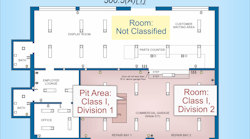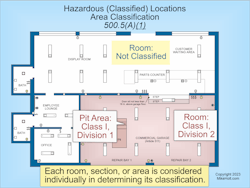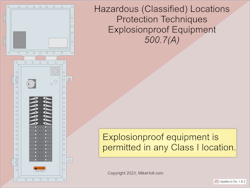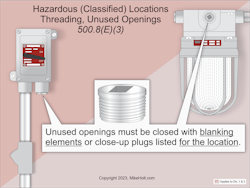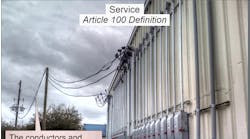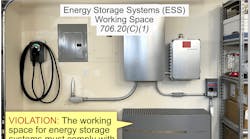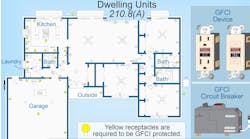A hazardous (classified) location is an area (not necessarily room or building) where the possibility of fire or explosion exists due to the presence of flammable or combustible vapors, or flammable gases, combustible dusts, or easily ignitable fibers/flyings. Electric arcs, sparks, and/or heated surfaces can serve as a source of ignition in such environments.
Article 500 provides the foundation for applying Art. 501 (Class I Locations), Art. 502 (Class II Locations), and Art. 503 (Class III Locations). This Article also provides a foundation for using Arts. 510 through 516.
Before you apply any of the Articles just mentioned, you must understand and use Art. 500, which is fairly long and detailed. It contains many Informational Notes you should review. Although Informational Notes are not NEC requirements [Sec. 90.5(C)], they help you better understand the related NEC rules.
Documentation
All areas designated as hazardous (classified) locations must be properly documented on an area classification drawing. The documentation must be available to those who are authorized to design, install, inspect, maintain, or operate the electrical equipment [Sec. 500.4].
Proper documentation of hazardous areas assists the designer, installer, and authority having jurisdiction (AHJ) in ensuring adherence to the stringent requirements in Arts. 501 through 516.
Classification
Determining the classification of a specific hazardous area is the responsibility of those who understand the dangers of the products being used. These people include the fire marshal, plant facility engineer, and insurance underwriter. It is not the responsibility of the electrical engineer, electrical contractor, or electrical inspector. Before performing any wiring in or near a hazardous (classified) location, contact the plant facility and design engineer to ensure that proper installation methods and materials are used. Be sure to review Sec. 500.4(B) for additional standards that might need to be consulted.
Locations are classified according to the properties of the flammable gases, flammable liquid-produced vapors, combustible liquid-produced vapors, combustible dusts, or easily ignitable fibers/flyings that may be present, and the likelihood that a flammable or combustible concentration will be present [Sec. 500.5(A)].
Each room, section, or area is considered individually in determining its classification (Fig. 1).
Informational Note: To reduce the need for expensive equipment and expensive wiring methods, use some ingenuity to locate as much electrical equipment as possible in an unclassified location.
Class I locations
A Class I location is an area where flammable gases, flammable liquid-produced vapors, or combustible liquid-produced vapors may be present in quantities sufficient to produce explosive or ignitable mixtures [Sec. 500.5(B)].
(1) Class I, Division 1 Location. A Class I, Division 1 location is a location in which:
(1) Ignitable concentrations of flammable gases, flammable liquid-produced vapors, or combustible liquid-produced vapors may exist in the course of normal operations, or
(2) Ignitable concentrations of flammable gases, flammable liquid-produced vapors, or combustible liquids above their flash points may exist due to repair or maintenance operations or because of leakage, or
(3) Breakdown or faulty equipment might release ignitable concentrations of flammable gases, flammable liquid-produced vapors, or combustible liquid-produced vapors and the electrical equipment becomes a source of ignition.
The Informational Note provides a list of 15 locations that are examples of Class I, Division 1 locations (there were 10 in the 2020 NEC).
(2) Class I, Division 2 Location. An area where volatile flammable gases, or combustible or flammable liquid-produced vapors, would become hazardous only in case of an accident or of some unusual operating condition, or under any of the following conditions:
(1) If flammable gases, flammable liquid-produced vapors, or combustible liquid-produced vapors are handled, processed, or used, but are normally confined within closed containers and the gases would escape only in the case of accidental rupture or breakdown or in the case of abnormal operation of equipment.
(2) If ignitable concentrations of flammable gases, flammable liquid-produced vapors, or combustible liquid-produced vapors are normally prevented by positive mechanical ventilation but might become hazardous through failure or abnormal operation of the ventilating equipment.
Class II Locations
Class II locations are hazardous because of the presence of combustible dust [Sec. 500.5(C)].
(1) Class II, Division 1 Location. A Class II, Division 1 location is an area where combustible dust may exist under any of the following conditions:
(1) Under normal operating conditions combustible dust is continuously or periodically suspended in the air in sufficient quantities to produce mixtures that will ignite or explode, or
(2) If faulty equipment releases ignitable mixtures of dust and the equipment becomes a source of ignition, or
(3) In which Group E combustible dusts may be present in quantities sufficient to be hazardous in normal or abnormal operating conditions.
Informational Note: Dusts containing magnesium or aluminum are particularly hazardous, use extreme precaution to avoid ignition and explosion.
(2) Class II, Division 2 Location. An area where combustible dust would become hazardous under any of the following conditions:
(1) If combustible dust, due to abnormal operations, may be present in the air in quantities sufficient to produce explosive or ignitable mixtures, or
(2) If combustible dust accumulation is normally insufficient to interfere with the normal operation of electrical equipment, but where malfunctioning equipment may result in combustible dust being suspended in the air, or
Class III Location
A Class III location is an area where easily ignitable fibers or materials producing combustible flyings are handled, manufactured, or used and are not likely to be suspended in the air in quantities sufficient to produce ignitable mixtures [Sec. 500.5(D)].
(1) Class III, Division 1 Location. A Class III, Division 1 location is an area where easily ignitable fibers/flyings are manufactured, handled, or used.
(2) Class III, Division 2 Location. A Class III, Division 2 location is an area where easily ignitable fibers/flyings are stored or handled other than in the manufacturing process.
Protection Techniques
Electrical and electronic equipment in hazardous (classified) locations must be protected by one or more of the techniques enumerated in Sec. 500.7(A) through (U). In the 2020 NEC, this list ended at (P). Some examples:
(A) Explosionproof Equipment. Explosionproof equipment is permitted in any Class 1 location for which it is identified (Fig. 2).
(C) Dusttight Enclosures. Dusttight enclosures are permitted in Class II, Division 2 or any Class III location.
(D) Purged and Pressurized Systems. Purged and pressurized systems are permitted for equipment in any hazardous (classified) locations for which they are identified.
(I) Oil-Immersed Contacts. Oil-immersed make-and-break contacts can be installed in a Class I, Division 2 location.
(J) Hermetically Sealed Contacts. Hermetically sealed contacts can be installed in Class I, Division 2; Class II, Division 2; or Class III locations.
Equipment
Articles 500 through 503 require equipment construction and installation that ensure safe performance under conditions of use and maintenance. You’ll find requirements for suitability and approval in Sec. 500.8(A) and (B). For example, equipment installed in any hazardous (classified) location must be identified for the class and the explosive, combustible, or ignitable properties of the specific gas, vapor, dust, or fiber/flyings that will be present [Sec. 500.8(B)(1)].
For Class I equipment, the Table 500.8(C)(4) temperature marking must not exceed the autoignition temperature of the specific gas or vapor that may be encountered [Sec. 500.8(D)(1)].
Class II equipment must not have exposed surfaces operating at a temperature in excess of the autoignition temperature of the specific dust as contained in Sec. 500.8(C)(4) [Sec. 500.8(D)(2)].
Threaded conduits must be made wrenchtight to prevent arcing when ground-fault current flows through the raceway system and to ensure the explosionproof or dust-ignitionproof integrity of the raceway system.
Threaded entries into explosionproof equipment must be made up with at least five threads fully engaged [Sec. 500.8(E)(1)].
Exception: Listed explosionproof equipment with factory NPT entries must be made up with four and one-half threads fully engaged.
This requirement ensures that if an explosion occurs within a raceway or enclosure, the expanding gas will sufficiently cool as it dissipates through the threads. This prevents hot flaming gases from igniting the surrounding atmosphere of a hazardous (classified) location.
Unused raceway and cable openings must be closed with listed metal close-up plugs installed per Sec. 500.8(E)(1) or (E)(2) [Sec. 110.12(A)] (Fig 3).
Keep the goal in mind
Remember, it is assumed the flammable atmosphere outside the raceway will seep into the raceway system over time. The goal of the Code is to contain any explosion that occurs inside the raceway so such an event will not ignite the flammable mixture outside the raceway. This fact has repercussions throughout the next 12 Articles of Chapter 5.
These materials are provided by Mike Holt Enterprises in Leesburg, Fla. To view Code training materials offered by this company, visit www.mikeholt.com/code.
